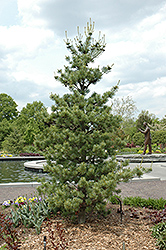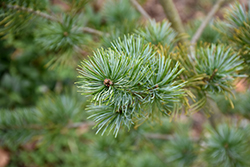Height: 20 feet
Spread: 15 feet
Sunlight:
![]()
Hardiness Zone: 5a
Description:
This outstanding variety is a slow growing semi-dwarf tree with a pyramidal habit when young, but may become more columnar with a flat top as it matures; features blue-green needles that are compressed against and tend to twist around the twigs
Ornamental Features
Venus Japanese White Pine is primarily valued in the landscape for its distinctively pyramidal habit of growth. It has attractive bluish-green evergreen foliage. The twisted needles are highly ornamental and remain bluish-green throughout the winter.
Landscape Attributes
Venus Japanese White Pine is a dense evergreen tree with a strong central leader and a distinctive and refined pyramidal form. Its relatively fine texture sets it apart from other landscape plants with less refined foliage.
This is a relatively low maintenance tree. When pruning is necessary, it is recommended to only trim back the new growth of the current season, other than to remove any dieback. It has no significant negative characteristics.
Venus Japanese White Pine is recommended for the following landscape applications;
- Accent
- Vertical Accent
Planting & Growing
Venus Japanese White Pine will grow to be about 20 feet tall at maturity, with a spread of 15 feet. It has a low canopy with a typical clearance of 1 foot from the ground, and is suitable for planting under power lines. It grows at a slow rate, and under ideal conditions can be expected to live for 80 years or more.
This tree should only be grown in full sunlight. It prefers dry to average moisture levels with very well-drained soil, and will often die in standing water. It is considered to be drought-tolerant, and thus makes an ideal choice for xeriscaping or the moisture-conserving landscape. It is not particular as to soil type or pH. It is somewhat tolerant of urban pollution. This is a selected variety of a species not originally from North America.
Disclaimer - This resource is provided for informational purposes only and does NOT reflect current availability. Inventory varies seasonally, so we cannot guarantee that every plant will be in stock at all times - please contact your favourite GardenWorks location directly for current availability. It does not include our entire inventory of plants, so be sure to visit GardenWorks to see varieties that may not be represented on this list.


